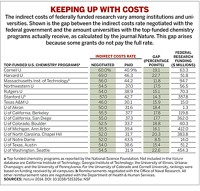Advertisement
Grab your lab coat. Let's get started
Welcome!
Welcome!
Create an account below to get 6 C&EN articles per month, receive newsletters and more - all free.
It seems this is your first time logging in online. Please enter the following information to continue.
As an ACS member you automatically get access to this site. All we need is few more details to create your reading experience.
Not you? Sign in with a different account.
Not you? Sign in with a different account.
ERROR 1
ERROR 1
ERROR 2
ERROR 2
ERROR 2
ERROR 2
ERROR 2
Password and Confirm password must match.
If you have an ACS member number, please enter it here so we can link this account to your membership. (optional)
ERROR 2
ACS values your privacy. By submitting your information, you are gaining access to C&EN and subscribing to our weekly newsletter. We use the information you provide to make your reading experience better, and we will never sell your data to third party members.
Policy
Barriers To Federal Tech Transfer
Regulations, policies impede commercialization of research from federal labs
by David J. Hanson
August 8, 2011
| A version of this story appeared in
Volume 89, Issue 32

Moving research and technology out of government laboratories and into the commercial sector is time-consuming and complicated. Congressional oversight, federal regulations, and differences in lab cultures are among the barriers that make technology transfer harder for the government than for research labs in the private sector.
A recent report from the Science & Technology Policy Institute (STPI)—a division of the Institute for Defense Analyses, a nonprofit group that works solely for the government—details these obstacles to tech transfer at the federal laboratories. The report also discusses entities that are working to smooth the transfer.
Technology transfer can be broadly defined as the movement of information and inventions out of the research laboratory and into the business world for commercialization. It includes, among other things, copyright and technology licensing and cooperative research and development agreements between industry and government. Successful federal tech transfer involves the cooperation of not only the businessperson and researchers, but also agency officials.
President Barack Obama has made innovation—including the translation of basic research into commercial products—a priority for his Administration. For instance, the Obama Administration has pushed a number of programs designed to enhance innovation, such as the Department of Commerce’s i6 Challenge (C&EN, April 4, page 29) and the recently announced federal effort called the Advanced Manufacturing Partnership to increase investment in emerging technologies for U.S. competitiveness (C&EN, July 4, page 10). These programs don’t specifically target tech transfer from federal labs, but they help create an environment that encourages commercial development of basic research in all sectors.
“There have been a number of studies done on the federal labs and other government-funded institutions about technology transfer,” says Stephanie Shipp, a research staff member at STPI and the project leader for the STPI report. “But I think with the new emphasis by this Administration and because a third of the federal R&D budget is allocated to the federal labs, there is renewed interest in how tech transfer can be accelerated and lead to commercialization in the private sector.”
Shipp notes that the STPI study is only a landscape review of a multilayered system and that it focuses on the administrative activities of in-house technology transfer offices at federal labs.
The most substantial barriers to tech transfer are institutional, including some federal regulations, congressional oversight, and even criticism by the media, the study found. For example, according to the study, in 1995, lawmakers eliminated a Department of Energy program that used some federal funds to partially pay for the transfer of federal inventions to private companies after news media deemed the program to be “corporate welfare.”
In another case, in 2003, members of Congress questioned the consulting activities of researchers at the National Institutes of Health as potentially constituting conflicts of interest. The inquiry resulted in high-profile congressional hearings and tighter controls by NIH officials over researchers’ extramural activities.
In general, the report concluded, these barriers have encouraged “a risk-averse culture toward technology transfer.” And they continue to persist. For example, the DOE inspector general in July warned Sandia National Laboratories that it needs to tighten oversight of patent agreements between the lab and the company that runs the lab, Lockheed Martin, to prevent potential conflicts of interest.
“The reaction to these instances by the agencies is to make them more risk averse,” Shipp says. “Even if they have the latitude to implement tech transfer policies, they react by avoiding risk or being less proactive in implementing technology transfer.”
Joseph P. Allen, president of Allen & Associates, a consulting firm working in technology transfer, concurs: “The federal system is risk averse,” he says. He adds that struggling with counterproductive rules affects personnel as well. “I’ve found that the best deal makers on the federal side leave after a while because they are fighting the whole system.” Allen has been involved in federal tech transfer for more than 20 years, including a stint as the director of the Department of Commerce’s Office of Technology Commercialization.
Federal rules can also inhibit or slow down tech transfer. For example, fairness of opportunity regulations, which require public notices of any intent to grant a license on a government patent, and laws mandating that companies partnering with the government use U.S. manufacturing facilities, are major roadblocks for companies, according to the report.
A different kind of obstacle to tech transfer is the unique environment of each government lab. Because of their missions, some labs produce basic research or regulatory science that is far removed from commercial markets. But others, such as Department of Agriculture labs and DOE’s National Renewable Energy Laboratory, have missions that allow them to work closely with businesses.
The priorities of the laboratory director also have a big impact in tech transfer. “The importance a lab director gives to tech transfer can really influence how the researchers respond,” Shipp says. And when researchers themselves are interested in marketing their work, tech transfer is more effective, according to Shipp and Allen.
“The researchers are the ones with the greatest passion” for their work, Allen says. But he has seen many of them get disappointed when they see barriers go up that prevent the commercialization of their research.
For example, government employees are prohibited from copyrighting computer software they produce at work. “This is a really controversial issue with sharply divided opinions on it,” Shipp notes. One side holds that the same rules of patenting by government employees should apply to technology, which employees can patent, as to software, which they cannot. The other view is that software developed with government funds should be publicly available.
Another problem is that agencies or tech transfer office officials have little incentive to push deals through. There are virtually no rewards for the agency and the lab for doing successful technology transfer, according to Allen. “It doesn’t reflect in the agency budget, and it doesn’t affect the bottom line. There are no consequences if you make good deals or if you don’t.”
The STPI study does note that individual researchers receive a percentage of royalties from the licensing of their patented inventions. But royalties have a maximum of $150,000 per year, and different labs pay different percentages on the royalties. For instance, the Defense Department’s Space & Naval Warfare Systems Command pays the researcher 40% of royalties, while Pacific Northwest National Laboratory pays 15%. Federal labs may also pay cash awards to researchers for inventions, innovations, computer software, or other outstanding contributions.
Much of the administrative work on tech transfer at federal labs is done through the individual labs’ offices of research and technology applications. The report finds, however, that the abilities and business knowledge of tech transfer staff at the many offices vary widely. The offices often focus on the administrative part of the task and not on business development or outreach to industry. For this and other reasons, such as failure by the labs to make their technology information readily accessible, many in industry are unaware of the business opportunities at the federal labs, the study says.
To bridge the gap, groups called partnership intermediaries have emerged that help “small businesses work with the labs to reduce the stress and the paperwork burdens,” Shipp says. “They have been shown to accelerate tech transfer from the labs.” Their service is especially important because small businesses have more difficulty getting tech transfer agreements with federal labs than do larger businesses. Often, Shipp explains, small business can’t pay for up-front costs, and they “often work on shorter timelines than the federal government does.”
An example of a successful intermediary is Maryland Technology Development Corp., or Tedco, which was set up in 1998. “All of the technology transfer intermediaries have a focus area,” according to Ronald W. Kaese, director of federal programs at Tedco. “We focus on the high-technology, seed stage start-up businesses, companies that are in the business incubator stages.”
Kaese has been mediating federal tech transfer for about nine years and confirms that “the government has unique facilities, equipment, data sets, and expertise that can facilitate the growth of our economy.” But small companies need a way to find access to these facilities and data sets if they are going to succeed, and the partnership intermediaries provide that access.
While conceding that some federal policies can make tech transfer harder, Kaese says his experience is that the labs, especially the researchers themselves, are eager to share their knowledge outside the government. “They have formed this camaraderie. They are used to peer review and sharing ideas to begin with. A lot of federal researchers are as congenial and interactive as you would find on any college campus,” he says.
One advantage Tedco can offer businesses is access to state funding, Kaese says. This is important because the limited funds government labs have for tech transfer, the STPI report notes, may prevent small businesses from being able to make deals with the labs.
The STPI group realizes that its landscape report is just one view of the complex tech transfer process, and it recommends that further studies be done, especially from the perspective of the researchers and those working in the laboratories. Another important factor for future study is the work of state and local economic programs, such as Tedco. Shipp and Allen say that any analysis of the system would be incomplete without getting input from industry as well.
Experts on tech transfer agree that a tremendous amount of useful innovation exists at the federal labs, and the tech transfer process needs to be improved to make the innovations more accessible. “There is just too much in the labs to give up,” Allen says. “I’ve seen some fantastic technologies there. We need to just break through the middle ground to make this thing really go.”





Join the conversation
Contact the reporter
Submit a Letter to the Editor for publication
Engage with us on Twitter